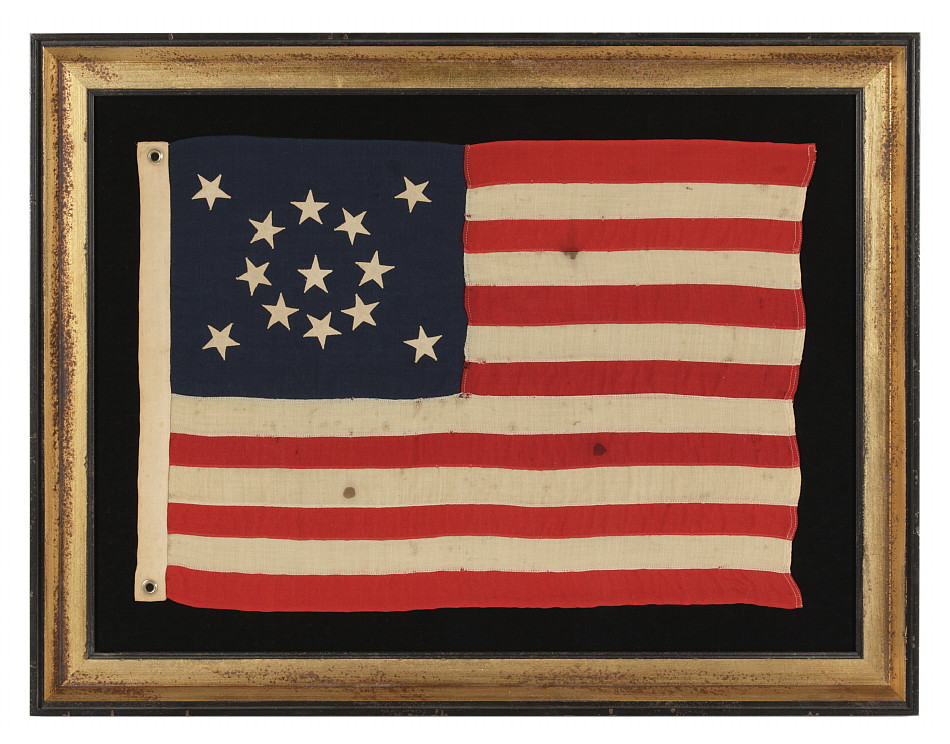
| |
13 STARS ARRANGED IN A MEDALLION PATTERN ON A SMALL-SCALE ANTIQUE AMERICAN FLAG OF THE 1895-1920's ERA |
|
| Available: |
Sold |
| Frame Size (H x L): |
35.5" x 46.25" |
| Flag Size (H x L): |
24.75" x 35" |
|
| Description....: |
|
13 STARS ARRANGED IN A MEDALLION PATTERN ON A SMALL-SCALE ANTIQUE AMERICAN FLAG OF THE 1895-1920's ERA:
13 star flag of a type made from roughly the last decade of the 19th century through the first quarter of the 20th. The stars are arranged in a beautiful configuration that consists of a single center star, surrounded by a wreath of 8 stars, with a flanking star in each corner of the blue canton. This design seems to have first appeared in 13 star flags of the Civil War era, became very popular at the time of the 1876 centennial of American independence--especially in small printed flags waved at parades and political events--then appears on approximately twenty-five percent of small pieced-and-sewn flags, such as this one, in the 1890-1920's era.
Why 13 Stars? As the number of stars grew with the addition of new states, it became more and more difficult to fit the full complement of stars on a small flag. The stars would, by necessity, have to become smaller, which made it more and more difficult to view them from a distance as individual objects. The fear was that too many stars would become one white mass and distort the ability to identify American ships on the open seas.
The U.S. Navy used 13 stars on its small-scale flags for precisely this reason. This was, of course, the original number of stars on the first American national flag, by way of the First Flag Act of 1777, and equal to the number of original colonies that became states.
For all practical purposes, commercial flag-makers simply didn't produce flags with pieced-and-sewn construction that were 3 to 4 feet in length before the 1890's. There are exceptions to this rule, but until this time the smallest sewn flags were approximately 6 feet on the fly. The primary use had long been more utilitarian than decorative, and flags needed to be large to be effective as signals. But private use grew with the passage of time, which led to the need for long-term use flags of more manageable scale.
Beginning around 1890, flag-makers began to produce small flags for the first time in large quantities. Most measured approximately 2 x 3 feet, like this example, or 2.5 x 4 feet, though there was certainly variation. Applying the same logic as the U.S. Navy, flag-makers chose the 13 star count rather than the full complement of stars for sake of ease and visibility. Any flag that has previously been official, remains so according to the flag acts, so 13 star flags were and still are official today.
13 star flags have been used throughout our nation's history for a variety of purposes. In addition to their use by the U.S. Navy and on the small scale commercially-made flags of the 1890-1920's era, they were hoisted at patriotic events, including Lafayette’s visit in 1825-26, the celebration of the nation's centennial in 1876, and the sesquicentennial in 1926. They were displayed during the Civil War, to reference past struggles for American liberty and victory over oppression, and were used by 19th century politicians in political campaigning for the same reason. The use of yachting ensigns with a wreath of 13 stars surrounding an fouled anchor, which allowed pleasure boats to bypass customs between 1848 and 1980, persists today without an official purpose. Navy use of 13 star flags ended in 1916, when an Executive Order of President Woodrow Wilson brought the practice to an end, just before U.S. involvement in WWI.
Construction: The canton and stripes of the flag are made of wool bunting that has been pieced with machine stitching. The stars are made of cotton and double-appliquéd (applied to both sides) with a zigzag stitch. There is twill cotton binding along the hoist with two white metal grommets.
Mounting: The flag has been hand-stitched to 100% natural fabrics for support on every seam and throughout the star field. Fabrics of similar coloration were placed behind the flag to mask minor losses. The flag was then hand-stitched to a background of twill cotton, black in color, which was washed to reduce excess dye. An acid-free agent was added to the wash to further set the dye and the fabric was heat-treated for the same purpose. The mount was then placed in a black-painted, hand-gilded and distressed Italian molding. The glazing is U.V. protective Plexiglas.
Condition: There is minor foxing and staining throughout, accompanied by three small but dark stains. There is minor mothing throughout. Many of my clients prefer early flags to show their age and history of use. |
|
|
|
| Collector Level: |
Beginners and Holiday Gift Giving |
|
| Flag Type: |
Sewn flag |
|
| Star Count: |
13 |
|
| Earliest Date of Origin: |
1895 |
|
| Latest Date of Origin: |
1926 |
|
| State/Affiliation: |
13 Original Colonies |
|
| War Association: |
|
|
| Price: |
Please call (717) 676-0545 or (717) 502-1281 |
|
| |
Views: 2366 |
|
|
|

